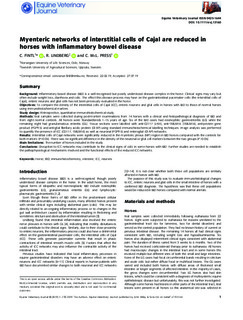| dc.contributor.author | Fintl, Constanze | |
| dc.contributor.author | Lindberg, Ronny | |
| dc.contributor.author | Press, Charles McLean | |
| dc.date.accessioned | 2020-01-03T12:42:28Z | |
| dc.date.available | 2020-01-03T12:42:28Z | |
| dc.date.created | 2019-12-02T16:28:38Z | |
| dc.date.issued | 2019 | |
| dc.identifier.citation | Equine Veterinary Journal, 2019 | nb_NO |
| dc.identifier.issn | 0425-1644 | |
| dc.identifier.uri | http://hdl.handle.net/11250/2634804 | |
| dc.description.abstract | Background
Inflammatory bowel disease (IBD) is a well‐recognised but poorly understood disease complex in the horse. Clinical signs may vary but often include weight loss, diarrhoea and colic. The effect this disease process may have on the gastrointestinal pacemaker cells (the interstitial cells of Cajal), enteric neurons and glial cells has not been previously evaluated in the horse.
Objectives
To compare the density of the interstitial cells of Cajal (ICC), enteric neurons and glial cells in horses with IBD to those of normal horses using immunohistochemical markers.
Study design
Retrospective, quantitative immunohistochemical study.
Methods
Ileal samples were collected during post‐mortem examinations from 14 horses with a clinical and histopathological diagnosis of IBD and from eight normal controls. All horses were Standardbreds 1–15 years of age. Six of the IBD cases had eosinophilic gastroenteritis (EG) while the remaining eight had granulomatous enteritis (GE). Tissue sections were labelled with anti‐CD117 (c‐Kit), anti‐TMEM16 (TMEM16), anti‐protein gene product (PGP9.5) and anti‐glial fibrillary acidic protein (GFAP) using standard immunohistochemical labelling techniques. Image analysis was performed to quantify the presence of ICC (CD117, TMEM16) as well as neuronal (PGP9.5) and enteroglial (GFAP) networks.
Results
Interstitial cells of Cajal networks were significantly reduced in the myenteric plexus (MP) region in IBD horses compared with the controls for both markers (P<0.05). There was no significant difference in the density of the neuronal or glial cell markers between the two groups (P>0.05).
Main limitations
The number of horses included in the study.
Conclusions
Disruption to ICC networks may contribute to the clinical signs of colic in some horses with IBD. Further studies are needed to establish the pathophysiological mechanisms involved and the functional effects of the reduced ICC networks. | nb_NO |
| dc.language.iso | eng | nb_NO |
| dc.rights | Attribution-NonCommercial-NoDerivatives 4.0 Internasjonal | * |
| dc.rights.uri | http://creativecommons.org/licenses/by-nc-nd/4.0/deed.no | * |
| dc.title | Myenteric networks of interstitial cells of Cajal are reduced in horses with inflammatory bowel disease | nb_NO |
| dc.type | Journal article | nb_NO |
| dc.type | Peer reviewed | nb_NO |
| dc.description.version | publishedVersion | nb_NO |
| dc.source.journal | Equine Veterinary Journal | nb_NO |
| dc.identifier.doi | 10.1111/evj.13160 | |
| dc.identifier.cristin | 1755663 | |
| cristin.unitcode | 192,16,4,0 | |
| cristin.unitcode | 192,16,1,0 | |
| cristin.unitname | Institutt for sports- og familiedyrmedisin | |
| cristin.unitname | Institutt for basalfag og akvamedisin | |
| cristin.ispublished | true | |
| cristin.fulltext | original | |
| cristin.qualitycode | 2 | |

